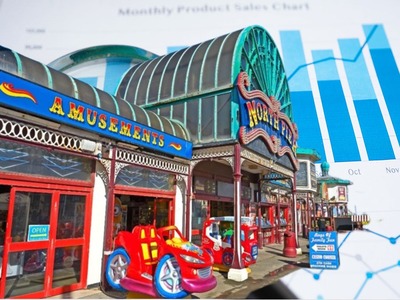 Did you know that there are more than 184,000 gaming and gambling machines in the UK, across all sectors of the industry?
Did you know that there are more than 184,000 gaming and gambling machines in the UK, across all sectors of the industry?
Well you do now, and although this article is about arcades, the majority of gaming machines are not actually located in these establishments.
What’s more, some of the machine categories are much more prevalent than others industry wide.
Even the word ‘arcade’ isn’t as straight forward as it may seem, because although it is a term we tend to use to mean any sort of venue that runs gaming machines, there is a distinct difference between a Family Entertainment Centre and an Adult Gaming Centre.
These sorts of establishments don’t look wildly different but the rules around them are not the same, and just to make matters even more confusing, they can usually be found in the same places as each other and even something under the same roof.
The rules around what types of machines different businesses are legally allowed to run, and how many of them, are quite complex so I won’t go into the real nitty gritty, but in order to understand the data you will need at least a basic understanding of what they all are, so let’s get that out of the way first.
Different Types of Gambling Machines and Premises
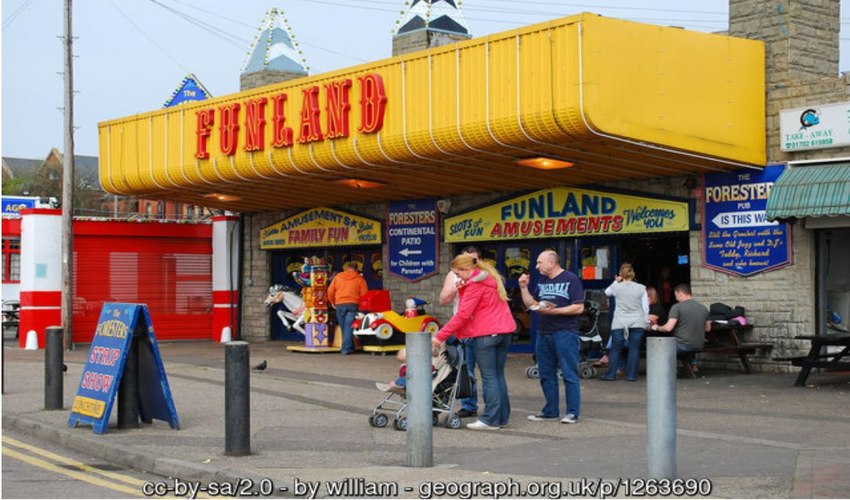
I’m straying into technical territory here, what with machine categories and the specifics of different types of premises, so very quickly, here’s what they all mean.
I’ll cover the premises first as that’s pretty easy to understand.
You will no doubt know the difference between a betting shop, casino, bingo hall, and race track, but when it comes to places which are colloquially known as arcades, things are less clear.
You’ve basically got:
- Adult gaming centres
- Family entertainment centres
Adult Gaming Centres (AGCs) are those mini slot casinos that you see in small towns; Admiral Casino is a good example that is nationwide. They can have a mix of B3, B4, C and D gaming machines, and are adults only establishments.
Family Entertainment Centres (FECs) are more like seaside arcades and they can be licensed or unlicensed, which dictates the kind of machines they are allowed to have, C or D.
They can include higher paying machines from other categories under certain conditions though, and this is why some have over 18s only areas inside them.
As for the machines themselves, we are talking about fruit machines or slots really, but it also extends to the more unique machines like penny pushers and crane grabbers.
| Category | Permitted Venue | Stake/Prize |
|---|---|---|
| B1 | casinos only | prizes up to £10,000, or £20,000 if part of a linked progressive jackpot with other machines in the same building |
| B2 | casinos, betting shops, racing tracks | £2 maximum stake, £150 maximum prize |
| B3 | casinos, betting shops, racing tracks, bingo halls, adult gaming centres | £2 maximum stake, £500 maximum prize |
| B4 | casinos, betting shops, racing tracks, bingo halls, adult gaming centres, members clubs | £2 maximum stake, £400 maximum prize |
| C | Anywhere with a license | £1 maximum stake, £100 maximum prize |
| D | anywhere with a license or permit | 10p to £1 machine dependent, with prizes of £5 to £50 |
The reason this is all so complex is because of the laws surrounding the different types of venues wanting to operate gaming machines.
Pubs and members clubs, for example, are not necessarily over 18s venues but they are a place aimed at adults for the most part. Therefore, they want to offer products that adults enjoy, like gaming machines, but they are restricted as to how many and what type they are allowed.
Pubs don’t need a gambling license for a small number of machines, just a permit, so it’s easier to get past the paperwork stage. However pubs (and any other business wanting to operate gaming machines) need to be kept distinct from gambling businesses, so there are different machines and different rules for different places.
The Number of Gambling Machines in the UK
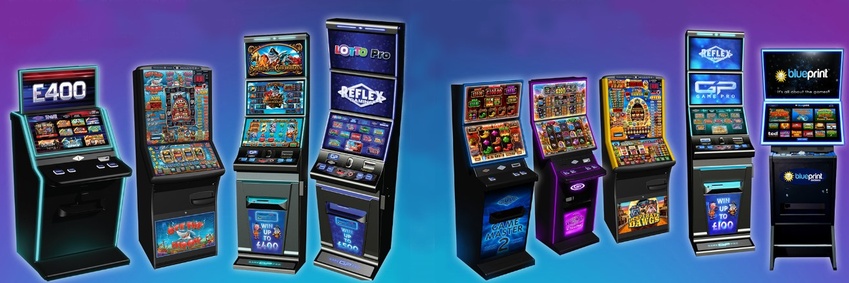
The first thing I noticed when looking at the total numbers, was that they had gone down from 184,387 to 151,260 between 2019 and 2022 – that’s 33,127 fewer machines and a drop of around 18%.
The last time the number of machines in the UK had dropped like that was between 2008 and 2011, which was the financial crash and the long recession.
In both instances, I would imagine the decrease in machine numbers is almost entirely due to the closure of businesses.
We know that covid spelled the end for many businesses, including pubs where a small number of machines would have been operating; and even big chain companies like Buzz bingo, Mecca bingo, and the casinos ended up closing a handful of locations to save money.
There were 2,085 betting shops closed between 2019 and 2022, 179 adult gaming centres, 58 Family Entertainment Centres, 9 casinos, and 22 bingo halls. Clearly then, this will have had a huge impact on gaming machine numbers.
Between the 2008 recession and covid, the number of machines in operation in this country grew year on year (apart from a small drop in 2017), and I would expect that to happen again as the country recovers.
Indeed, figures from 2023 show a rapid increase back to pre-covid numbers: 184,126 machines to be exact.
Another obvious change is the sudden drop in B2 machines and the sudden jump in B3 machines during 2019, due to regulation changes regarding Fixed Odds Betting Terminals at this time. The maximum stakes on B2 machines were reduced from £100 to £2 after much campaigning, so bookies switched to B3 machines to avoid some of the heat.
Family Entertainment Centre and Adult Gaming Centre Revenues
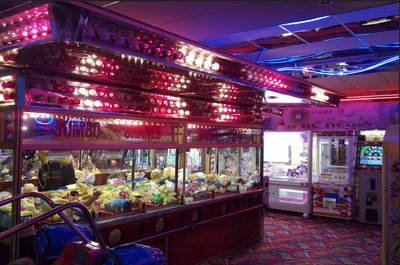
Family Entertainment Centres are places for light entertainment, with softer gambling games available that even children can play.
It is no surprise then to see that the majority of the revenue from FECs is courtesy of category D machines – over 95% in fact.
This is a consistent long-term trend too, with category C machines responsible for no more than around 5% since 2013.
Having grown up in a seaside town that was full of arcades, I can totally understand this. True family entertainment centres don’t have a great number of category C machines, because they tend to be places that people take their kids.
There is a Hollywood Bowl near me that is always busy, and they have an FEC in there with all sorts of weird and wonderful machines, but almost all of them are category D, with just the odd cat C for the parents.
This is just about understanding your target market so I can’t see it changing as time goes on.
When it comes to Adult Gaming Centres (AGCs), they are made up of B3, B4, C, and D category machines. That said, there are practically no B4 machines operating in them anymore, but it was a surprise to see how many D category machines were still in use considering the clientele.
This chart shows the number of each machine in AGCs in the UK as of 2023, along with the gross gambling yield of each category specifically from AGCs:
| Category | # Machines | GGY (£m) |
|---|---|---|
| B3 | 12,492 | £381 million |
| B4 | 71 | £0.61 million |
| C | 36,233 | £136 million |
| D | 16,696 | £16 million |
What I found incredible about this data is the disparity between the number of B3 machines in AGCs and their gross gambling yield, compared to that of the C category machines.
In 2023, B3 machines represented 19.07% of the total number of machines in AGCs but were responsible for 71.48% of the revenue. In contrast, category C machines accounted for 55.32% of all machines in adult gaming centres, but just 25.51% of the revenue.
Category D machines don’t really perform for AGCs at all next to B3s and Cs; they were 25.49% of the total number of machines (so more than B3s) yet only brought in 3% of the revenue. I’m not sure why AGCs include them in such numbers, unless it is strategic to allow them to also have more of the other machine types (regulations state how many of each machine category you can have in one venue based on the total machine number).
That just leaves B4 machines, which are sort of pointless outside of members clubs, because as a player you can use the same maximum stake and play on a B3 which has a higher max payout, so why would you risk your money for the smaller prize?
I wouldn’t be surprised to see these die out completely.
Gaming Machines in Other Gambling Sectors
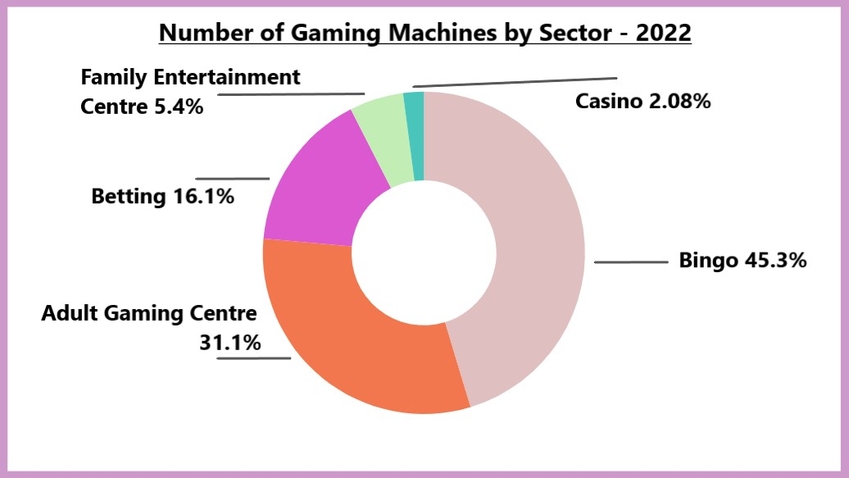
Stepping away from arcades now, and it may interest you to see the spread of gaming machines across the gambling industry as a whole.
You can see that it is actually bingo halls that are responsible for the largest number of gaming machines in the UK (and as covered in the bingo article, they make more money from gaming machines than from bingo!)
This might be a surprise if you have never been in a bingo hall, but they all have what basically amounts to an adult gaming centre inside the venue that runs alongside the bingo room, with a good hundred or so machines chirping away.
Adult gaming centres are the next biggest operator of gaming machines, and with more than 1,340 of them in the UK, all running anything from 20-50 machines, this makes sense.
Betting shops are allowed a maximum of 4 gaming machines on their premises, and obviously, where space allows, most hit this maximum. With around 6,000 betting shops in the UK, you can understand why they account for a larger percentage of the total gaming machine population than might have been expected.
The low proportion made up from family entertainment centres and casinos is partly down to space in regards to FECs (category D machines tend to be larger and FECs aren’t usually huge), and when it comes to casinos it’s down to their number.
There are just 144 casinos in the UK, and not all of them are huge. The law categorises casinos into ‘small’ and ‘large’, with small casinos allowed up to 80 machines at a machine to table ratio of 2:1, while large casinos are allowed up to 150 machines at a machine to table ratio of 5:1.
Casinos must therefore balance their number of machines with the number of roulette, blackjack, baccarat, and poker tables, as well as the space they have to work with and the staff costs to work the tables.
Look at the number of machines compared with the gross gambling yield of machines in each sector for 2023 though:
| Sector | % Machines | % GGY |
|---|---|---|
| AGCs | 35.57% | 22.41% |
| Betting Shops | 13.01% | 52.16% |
| Bingo Halls | 42.97% | 15.33% |
| Casinos | 1.71% | 8.47% |
| FECs | 6.74% | 1.63% |
Despite only accounting for around 13% of the gaming machines in the UK, betting shops took more than 52% of the GGY of gaming machines industry wide.
At the other end of the scale, bingo halls have more than 42% of the UKs gaming machines, but only around 15% of gaming machine GGY comes from them.
So machines in betting shops and casinos get hit pretty hard looking at this data, while those in bingo halls and AGCs might be making money, but they spend a lot of time waiting for a customer to come along and give the reels a spin.
